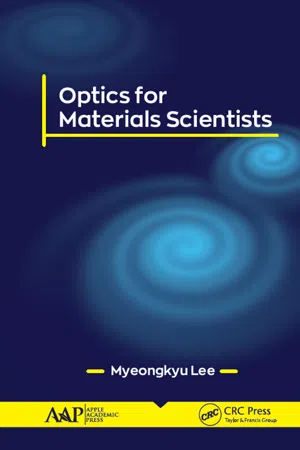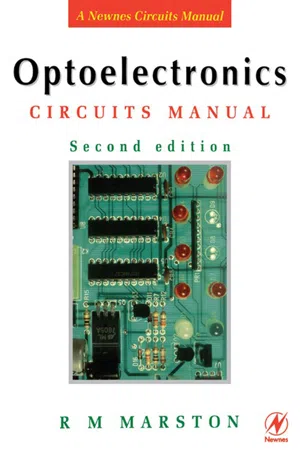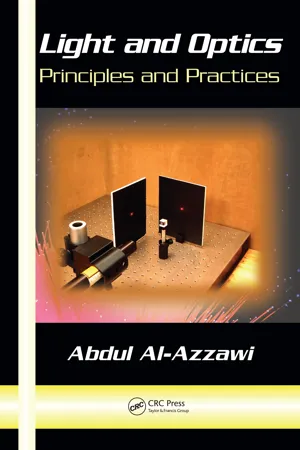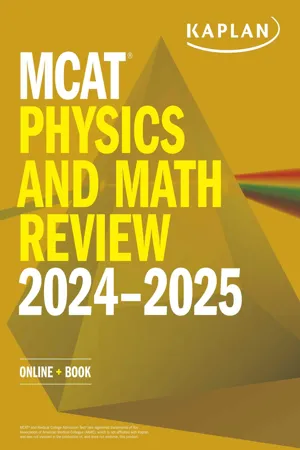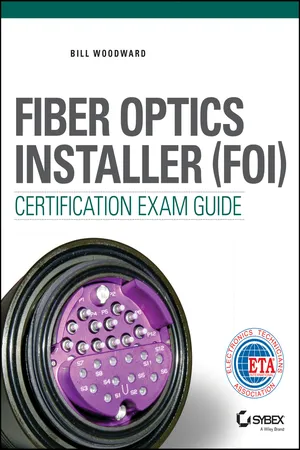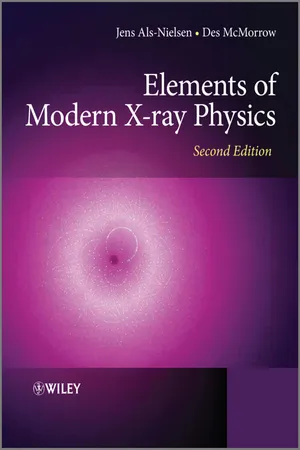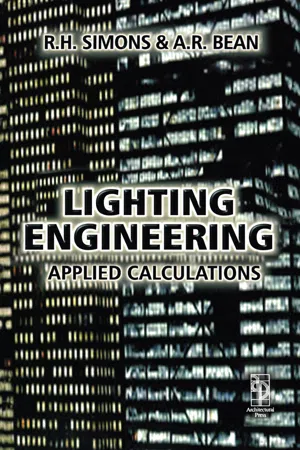Physics
Prism Light Refraction
Prism light refraction refers to the bending of light as it passes through a prism, causing the light to separate into its component colors. This phenomenon occurs due to the change in speed of light as it moves from one medium to another within the prism. The refraction of light in a prism is responsible for the creation of rainbows and the dispersion of white light into its spectral colors.
Written by Perlego with AI-assistance
Related key terms
Related key terms
1 of 4
Related key terms
1 of 3
8 Key excerpts on "Prism Light Refraction"
- eBook - ePub
- Myeongkyu Lee(Author)
- 2019(Publication Date)
- Apple Academic Press(Publisher)
CHAPTER 2Reflection and Refraction
2.1 INTRODUCTION
In this chapter, we describe a variety of phenomena occurring when a light wave passes from one medium to another. Consider a wave impinging on the interface separating two different media. As we already know from daily life, a portion of the incident energy bounces off the interface in the form of a reflected wave, while the remainder is transmitted across the boundary. When the wave is obliquely incident onto the interface, it is partially reflected and partially refracted. Refraction refers to the change in propagation direction of a wave when it enters a medium of different refractive index. The phenomenon is mainly governed by the law of energy and momentum conservation. It is commonly observed when a wave passes from one medium to another at any angle other than 0° from the normal. Light refraction is the most commonly observed phenomenon, but any type of wave can be refracted when it interacts with a medium. Refraction is also responsible for rainbows and for the splitting of white light into a rainbow-spectrum as it passes through a glass prism. A long object such as a pencil or wood stick obliquely immersed in water looks bent due to refraction. This is because a light ray reflected from the tip of the object refracts as it leaves the surface of water. Thus, the ray conceived by our eyes looks as if it were reflected from a point other than the tip of the object. Understanding of this concept led to the invention of lenses and glasses.The refraction of light is quantitatively described by Snell’s law. This law represents the relationship between the angles of incidence and refraction, when a light wave passes through a boundary between two isotropic media with different refractive indices. Snell’s law can be derived from Fermat’s principle or the application of boundary conditions for electromagnetic waves. The detailed behaviors of reflection and refraction in a given situation are well explained by the Fresnel equations, which describe what fraction of the incident light is reflected and what fraction is refracted (i.e., transmitted) at a planar interface separating two optical media. They also describe the phase shift of the reflected light. It will be shown that all these quantities depend not only on the change in refractive index and the angle of incidence, but also the polarization state of the incident light. This chapter treats the general features associated with the propagation, reflection, and refraction of light in isotropic media. These media are assumed to be linear, homogeneous, and nonmagnetic. As discussed in Chapter 1 - eBook - ePub
- R M MARSTON(Author)
- 1999(Publication Date)
- Newnes(Publisher)
dispersion.Figure 9.16 Exaggerated diagram showing a prism splitting a beam of white light into its component coloursWhen a ray of light passes through air and enters a prism, it bends by an amount determined by its angle of incidence and by the refractive index value of the glass. When the ray leaves the prism again and returns to the air, it bends by an amount determined by its angle of incidence and by the refractive index of the air (1.0) divided by that of the glass (say 1.5), and this value is invariably less than zero (0.667 in this example). Figure 9.17 shows the actual amounts of output refraction that occur on three different prisms that each have a refractive index of 1.5.Figure 9.17 Diagram illustrating the phenomenon of total internal reflection in a prismIn Figure 9.17 , the ray strikes the output surface of prism A at an incident angle of 30° and leaves the prism at a refractive angle of 42°; this prism thus bends the ray downwards by 12°. In the case of prism B, the ray strikes its output surface at an incident angle of 40° and leaves at a refractive angle of 85°, thus bending the ray downwards by 45°.Note in the case of prism B that the ray leaves the prism at an angle that is only 5° less than the angle of slope of the prism’s output face, and it is obvious that if the angle of incidence is increased much more the ray will be unable to penetrate the prism’s output surface. The angle of incidence at which this occurs is known as the surface’s critical angle , and is dictated by the n value of the glass; the critical angle is 43° at an n value of 1.5, 36° at an n value of 1.7, and 32° at an n value of 1.9.Figure 9.17 shows, in the Prism C diagram, what happens to the light rays when they strike the prism’s output face at an incident angle of 45°, i.e. at an angle greater than the critical angle of the surface. Under this condition a phenomenon known as total internal reflection - eBook - ePub
Light and Optics
Principles and Practices
- Abdul Al-Azzawi(Author)
- 2018(Publication Date)
- CRC Press(Publisher)
This experiment is designed to demonstrate the theory of light by passing light through both a single prism and through prism combinations. It also demonstrates light dispersion into a spectrum by a prism. Since the index of refraction varies with the wavelength, the angles of refraction are wavelength dependent. When white light enters a prism, the colour rainbow (a sequence of red, orange, yellow, green, blue, and violet colours) exits the prism, because the refractive deviation increases steadily with decreasing wavelength. In this experiment the student will perform the following cases:a. Observe a laser beam passing through a right angle prism and draw the laser beam path. b. Observe a laser beam passing through a Dove prism and draw the laser beam path. c. Observe a laser beam passing through a Porro prism and draw the laser beam path. d. Observe a laser beam passing through a prism and draw the laser beam path. e. Observe a laser beam passing through prisms in different arrangements and draw the laser beam path through the prism combinations. f. Use a laser beam to calculate the index of refraction of a prism. g. Use white light passing through a prism to observe a rainbow of colours. Measure the refractive deviation angle of the rainbow colours and calculate the index of refraction of the prism. h. Mix the spectrum colours using a glass rod and tube.11.9.1 TECHNIQUE AND APPARATUSAppendix A presents the details of the devices, components, tools, and parts.1. 2×2 ft. optical breadboard - No longer available |Learn more
MCAT Physics and Math Review 2024-2025
Online + Book
- (Author)
- 2023(Publication Date)
- Kaplan Test Prep(Publisher)
Chromatic aberration, discussed below, is predominantly seen in spherical lenses.If you remember back to conic sections from your precalculus class, it should be no surprise that spherical mirrors and lenses do not focus light perfectly. Parabolas are perfect reflectors, meaning that parallel light rays are reflected perfectly through the focal point. This is used in extracorporeal shock wave lithotripsy, in which a parabolic mirror is positioned with a kidney stone at the focal point. Sound waves are reflected off of the mirror and create enough vibration in the kidney stone to shatter it.Dispersion
As discussed earlier, the speed of light in a vacuum is the same for all wavelengths. However, when light travels through a medium, different wavelengths travel at different speeds. This fact implies that the index of refraction of a medium affects the wavelength of light passing through the medium because the index of refraction is related to the speed of the wave byn =It also implies that the index of refraction itself actually varies with wavelength. When various wavelengths of light separate from each other, this is called dispersion. The most common example of dispersion is the splitting of white light into its component colors using a prism.c v.If a source of white light is incident on one of the faces of a prism, the light emerging from the prism is spread out into a fan-shaped beam, as shown in Figure 8.13. This occurs because violet light has a smaller wavelength than red light and so is bent to a greater extent. Because red experiences the least amount of refraction, it is always on top of the spectrum; violet, having experienced the greatest amount of refraction, is always on the bottom of the spectrum. Note that as light enters a medium with a different index of refraction, the wavelength changes but the frequency of the light does not.Figure 8.13. Dispersion in a PrismDue to their different speeds while inside the prism, the various wavelengths of light are refracted to different degrees.Chromatic Aberration
Chromatic aberration - Bill Woodward(Author)
- 2014(Publication Date)
- Sybex(Publisher)
To explain refraction, we have to look at the wave nature of light. Recall that light consists of two perpendicular waves, and that the light travels in a path that forms right angles with both waves.As the light wave meets the boundary between media with different refractive indexes, that portion of the light wave changes velocity or it experiences a phase velocity change, while the rest of the light wave maintains its original velocity. A change in the phase velocity of a light wave typically causes the light wave to change direction as described by Snell's law, which is discussed in detail later in this chapter. Figure 3.8 shows light waves changing direction because of a change in phase velocity as multiple light waves cross from a lower refractive index into a higher refractive index.Light waves changing direction because of a change in phase velocityFigure 3.8The velocity of light through different media such as glass depends on the light's wavelength. One of the most common ways to observe this is by seeing how white light is refracted through a prism and broken up into its component wavelengths, as shown in Figure 3.9 . Notice that violet, which has the shortest visible wavelength, is refracted more than red, which has the longest visible wavelength. In this example, the red light changed direction the least and is traveling the fastest through the prism, while the violet light changed direction the most and is traveling the most slowly through the prism.It is important to remember that different wavelengths of light travel at different speeds in an optical fiber.Refraction of white light into component colorsFigure 3.9Calculating the Index of Refraction
We know the velocity of light can change and its velocity depends on its wavelength and the index of refraction of the medium it is passing through. We also know that the higher the refractive index, the slower the light travels. In other words, the speed of light (c- eBook - ePub
- Jens Als-Nielsen, Des McMorrow(Authors)
- 2011(Publication Date)
- Wiley(Publisher)
Chapter 3 Refraction and reflection from interfacesA ray of light propagating in air changes direction when it enters glass, water or other transparent materials. This is the basis for the classical optics of lenses. Quantitatively, the phenomenon is described by Snell’s law. For visible wavelengths the refractive index n of most transparent materials has a value in the range between 1.2 and 2. The refractive index depends on the frequency ω of the light, so that blue light is refracted more than red light, etc.The index of refraction for electromagnetic waves displays resonant behaviour at frequencies corresponding to electronic transitions in atoms and molecules. On the low frequency side of a resonance, n increases with ω, and this is known as normal dispersion. Immediately above the resonance frequency it decreases, and as more and more resonances are passed, the magnitude of the index of refraction decreases. X-ray frequencies are usually higher than all transition frequencies, perhaps with the exception of those involving the inner K- or maybe L-shell electrons. As a result in the X-ray region n turns out to be less than unity. (See Fig. 1.8 and accompanying discussion.) This reflects the phase shift of π in the Thomson scattering of X-rays, as we shall see. Moreover, it leads to the phenomenon of total external reflection from a flat, sharp interface: for incident glancing angles α below a certain critical angle αc the ray will no longer penetrate into the material but will be totally reflected from it. The deviation of n from unity is tiny, so the critical angle is small. The reader might wonder how n can be less than unity, since the velocity in the material is c /n , and this would seem to imply that the speed of light is higher in the material than in vacuum. However, c /n is the phase velocity, not the group velocity. The latter, evaluated as d ω/d k, is indeed less than c - Abraham Wolf(Author)
- 2019(Publication Date)
- Routledge(Publisher)
It was at first a very pleasing diversion to view the vivid and intense colours produced thereby; but after a while applying myself to consider them more circumspectly, I was surprised to see them in an oblong form; which, according to the received laws of refraction, I expected would have been circular” (Phil. Trans., No. 80). See Illustr. 156. Illustr. 156.—The Spectrum of Light Setting his prism at the position of minimum deviation, Newton found that the length of the spectrum was about five times that of the spot of light thrown by the beam when unrefracted. He thought of various explanations, as that the light might be scattered by irregularities in the glass; but a second, inverted prism completely neutralized the effect of the first. The rays, he thought, might follow curved paths after refraction, but this was found not to be so. Newton finally isolated the several colours in succession, and upon refracting each beam with a second prism (Illustr. 157), he found that the several colours showed unequal amounts of refraction. This experiment Newton, in Baconian phrase, called his experimentum crucis (crucial experiment). He later supplemented it by another experiment in which light, after suffering refraction at one prism so as to form an upright band on the wall, was passed through a second prism with its axis perpendicular to that of the first. The breadth of the resulting band of colours was not increased by the second refraction, but the spectrum became oblique, the colours which suffered the greater refraction at the first prism suffering the greater refraction at the second. He concluded that sunlight, and white light generally, is composed of rays of every colour, such colours being “original and connate properties” of the light, not manufactured by the prism- eBook - ePub
- R. H. Simons, A.R. Bean(Authors)
- 2008(Publication Date)
- Routledge(Publisher)
The profile may be rotated about the axis SX. This produces a beam of light in one direction when the source is located at S. Second, it may be rotated about an axis through S and parallel to AC, which produces a beam in all directions of azimuth, providing the source emits light in all the relevant directions. This is useful for beacons. Third, it can be generated as a linear prism panel in a plane through AC and perpendicular to SX, which is useful for controlling the light from linear sources. 6.8.12 LIGHT GUIDES USING REFRACTION One fascinating phenomenon occurring in optics is the way that light can be guided or ‘piped’ along a rod, block or sheet of transparent material by making use of total internal reflection. This is a very much more efficient method of conduction or transport than is provided by conventional mirror surfaces (see Section 6.6, page 232). At best, these have a reflectance of about 95% so that there is a considerable loss of light after comparatively few reflections. On the other hand, total internal reflection gives a reflectance approaching 100% and, provided the material of the light guide has a good transparency, light loss is considerably less. Figure 6.54 shows how light is transported in a sheet or rod RSTU of optically clear material. Light enters the face RU from all directions and, at each point, is concentrated into a cone having a total apical angle equal to twice the critical angle c. An extreme ray VW is shown reaching the face RS at W. It makes an angle 90° – c with the normal NW. If the material has a refractive index of 1.5, c will be 43°, so that the angle of incidence at W will be 90° – 43° or 47°, which is greater than the critical angle for the material
Index pages curate the most relevant extracts from our library of academic textbooks. They’ve been created using an in-house natural language model (NLM), each adding context and meaning to key research topics.
Explore more topic indexes
Explore more topic indexes
1 of 6
Explore more topic indexes
1 of 4
